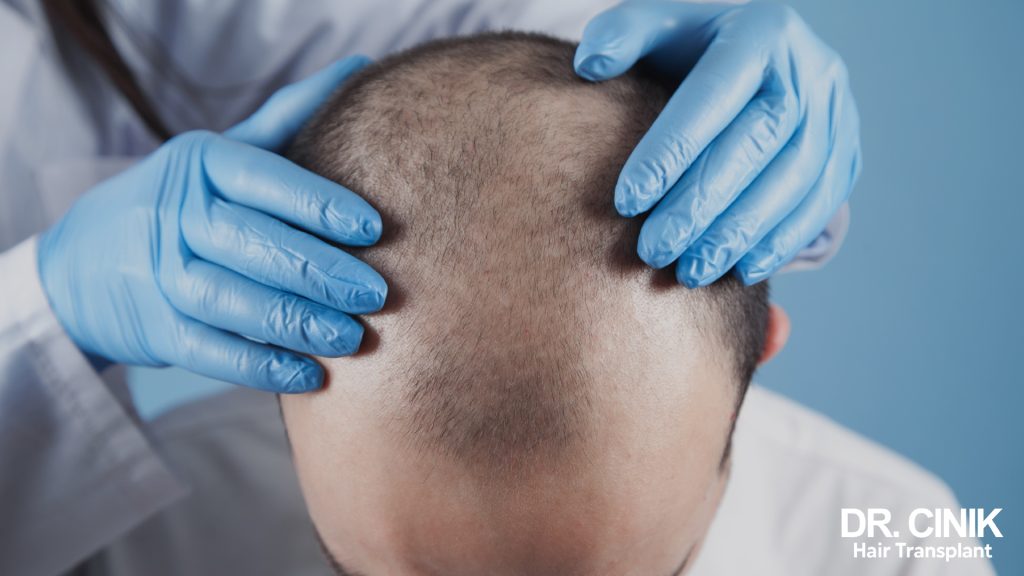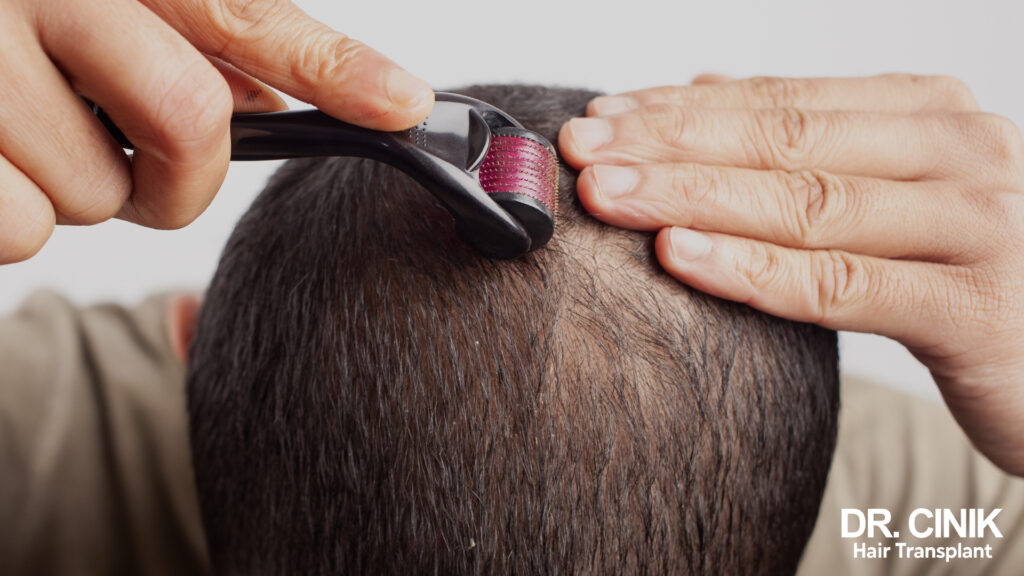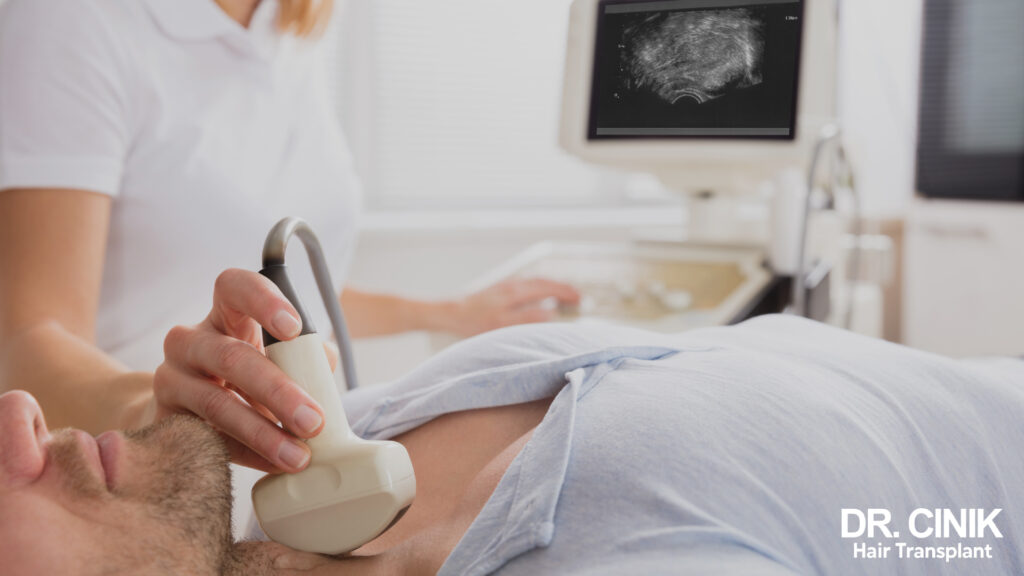Hair Loss Treatment: Your Comprehensive Guide to Slowing Loss and Achieving Regrowth

Sommaire
Hair loss, also known as alopecia, is a global concern that affects millions of people across all demographics. The Canadian Dermatology Association states that over 50% of men will experience hair thinning or loss. Beyond the physical manifestation, hair loss’s emotional and psychological toll cannot be overlooked. Many people suffering from hair loss report a significant loss of self-esteem, increased anxiety, and, in some cases, depression. The implications of hair loss reach far beyond the cosmetic, impacting the quality of life and mental health of those afflicted. In light of the wide-reaching effects of hair loss, this guide explores various treatment options available to those affected, shedding light on the pros and cons of each. Our objective is to provide a comprehensive understanding of this procedure, empowering those suffering from hair loss with the knowledge to make informed decisions about their treatment.

Understanding the Causes of Hair Loss
Genetic Predispositions (Pattern Hair Loss)
One of the primary factors contributing to hair loss is genetics. Scientific research has established a strong correlation between family history and the likelihood of experiencing hair loss. A key study published in the American Journal of Human Genetics found that a specific gene, the AR gene, plays a significant role in hair loss, particularly in cases of Androgenetic Alopecia (Pattern Hair Loss). This gene is associated with the hair follicles’ reaction to dihydrotestosterone (DHT), a derivative of the hormone testosterone. An oversensitivity to DHT can lead to follicular shrinkage, resulting in thinner and shorter hair.
The absence of a family history of hair loss does not exempt one from experiencing it. Other factors such as hormonal changes, nutritional deficiencies, and certain health conditions can also contribute to hair loss, emphasising this condition’s complex and multifaceted nature.

Medical Conditions and Hair Loss
Thyroid Issues
Thyroid disorders, both hyperthyroidism (an overactive thyroid) and hypothyroidism (an underactive thyroid) can lead to hair loss. The thyroid gland regulates the body’s metabolism, including hair, skin, and nail growth. When thyroid hormone levels are imbalanced, it can disrupt the hair growth cycle, resulting in hair loss. It’s worth noting that hair loss associated with thyroid disorders is usually diffuse, meaning it’s spread evenly over the scalp.

Autoimmune Diseases
Autoimmune diseases such as alopecia areata can also result in hair loss. These conditions occur when the immune system mistakenly attacks the body’s own cells – in this case, the hair follicles. This attack disrupts the normal hair growth cycle, causing hair to fall out. The severity of hair loss can vary from small, round patches on the scalp (alopecia areata) to complete loss of scalp and body hair (alopecia universalis).
Hormonal Imbalances
Hormonal imbalances can also contribute to hair loss. Fluctuations in hormones often occur during periods of change such as puberty, pregnancy, and menopause or due to conditions like Polycystic Ovary Syndrome (PCOS). An imbalance of sex hormones like estrogen and testosterone can disrupt the hair growth cycle, leading to thinning or loss. Additionally, stress can lead to hormonal imbalances, further exemplifying how our hair health can be a barometer of our overall well-being.
Lifestyle Factors and Hair Loss
Stress and Hair Loss
Stress can profoundly impact our overall health and well-being; hair health is no exception. Prolonged periods of stress can lead to various hair loss conditions, including telogen effluvium, trichotillomania, and alopecia areata. When our bodies experience severe stress, they may enter a survival mode where energy is redirected from non-essential functions, like hair growth, to more essential tasks. This shift can disrupt the normal hair growth cycle, causing hair to enter the telogen (resting) phase prematurely, leading to shedding and thinning.

Poor Diet and Hair Loss
Nutritional deficiencies resulting from a poor diet can contribute to hair loss. Hair follicles require a mix of protein, iron, essential fatty acids, and various vitamins and minerals to maintain normal hair growth. For instance, iron plays a crucial role in producing hair cell protein. Deficiency in this vital nutrient can lead to anaemia, a condition associated with hair loss. Likewise, insufficient protein intake, the hair’s building block, can impact the hair growth cycle. B vitamins, particularly Biotin, are also essential for hair health. Biotin deficiency, although rare, can result in thinning of the hair.
Lack of Exercise and Hair Loss
While the relationship between exercise and hair health is less direct, a lack of physical activity can lead to conditions that promote hair loss. Regular exercise aids in maintaining healthy circulation, which is essential for delivering nutrients to the scalp and removing waste products from hair cells. Furthermore, regular physical activity can help manage stress and maintain hormonal balance, both of which can impact the health of your hair.
Hair Loss treatment options :
Medication-Based Treatments
Minoxidil
Minoxidil, commercially known as Rogaine®, primarily works by prolonging the hair follicle growth cycle’s anagen phase (growth phase) and promoting increased blood flow to the scalp. This medication is available in two concentrations: a 2% solution recommended for women and a 5% solution used by men. Minoxidil is typically applied directly to the scalp twice daily, and while it can slow hair loss and stimulate hair growth, its effects are only maintained as long as the treatment is continued.

Finasteride
Finasteride, often sold under the brand name Propecia, is used to treat pattern baldness. Unlike Minoxidil, it requires a doctor’s prescription. Finasteride works by inhibiting the conversion of testosterone into dihydrotestosterone (DHT), the hormone that can cause hair follicles to shrink and lead to hair loss. This drug is typically taken orally once per day. While Finasteride can effectively reduce hair loss and promote new growth, it also requires ongoing use to maintain these benefits.

How effective are these treatments?
While medications, such as Minoxidil and Finasteride, have been proven effective in slowing down hair loss and promoting hair regrowth, it is important to understand that they are not a permanent solution. According to long-term studies, the effectiveness of these treatments relies on continued use. Once discontinued, any hair regrowth usually falls out within several months. Therefore, these medications are more accurately described as management strategies for hair loss rather than cures.
Hair Medicine as an Emerging Field
Platelet-Rich Plasma (PRP) Therapy
Platelet-rich plasma (PRP) hair therapy is an innovative treatment option for hair loss. PRP is derived from a patient’s blood, which is centrifuged to concentrate the platelets, rich in growth factors. The PRP is then injected into the scalp, where the growth factors help to stimulate hair follicle activity and promote new hair growth. The procedure relies on the body’s natural healing abilities and has shown promising results in treating hair loss.

Laser Hair Therapy
Laser hair therapy, or low-level laser therapy (LLLT), uses specific light wavelengths to stimulate hair follicles. The low-level lasers are thought to promote blood flow and increase the delivery of nutrients to the hair follicles, which can promote hair’s anagen (growth) phase.

Regenera Activa
Regenera Activa is a relatively new addition to the arsenal of hair loss treatments. This technique involves extracting hair follicle cells from healthier areas of the scalp, creating a suspension, and then injecting this suspension into areas of hair loss. The idea is that these healthier, more active cells will rejuvenate dormant hair follicles and stimulate them to grow hair again.

Lifestyle Changes and Diet
Role of a Balanced Diet in Hair Health
A balanced diet plays a pivotal role in maintaining hair health. It provides the essential nutrients our hair needs to grow and stay strong.
Iron
Iron is an important mineral for hair, and its deficiency can lead to hair loss. This essential nutrient aids in producing haemoglobin in our blood, which is necessary for providing oxygen for the growth and repair of cells that stimulate hair growth.
Omega-3 Fatty Acids
Omega-3 fatty acids are healthy fats that our body cannot produce itself, and thus, must be obtained through our diet. These fatty acids are found in the cells that line the scalp and provide the oils that keep your scalp and hair hydrated. Foods rich in Omega-3 include fatty fish like salmon, avocados, walnuts, and flaxseeds.

Protein
Hair is primarily made up of protein, making it a crucial nutrient for hair health. A lack of protein in the diet has been shown to promote hair loss. Therefore, it is essential to include sufficient protein in your diet. Good protein sources include chicken, turkey, fish, dairy products, legumes, and nuts.
Exercise and Stress Management for Healthy Hair
Regular exercise and stress management techniques like yoga and meditation can also play a vital role in maintaining hair health.
Exercise
Physical exercise isn’t just good for your body; it’s also beneficial for your hair. Exercise can improve blood circulation, which is crucial for scalp health and hair growth, as it provides nutrients and oxygen to the hair follicles. Moreover, exercise assists in balancing hormone levels, which can help prevent hair loss related to hormonal imbalances.

Yoga and Meditation
Stress is a significant contributor to hair loss. Yoga and meditation are excellent stress management techniques that promote relaxation and can help decrease levels of stress hormones in the body. By reducing stress, these practices can help mitigate stress-related hair loss. Yoga, in particular, can benefit hair health as certain poses, such as forward bends and inverted poses, are believed to improve blood circulation to the scalp, aiding in nutrient delivery to hair follicles.
Impact of Smoking and Alcohol Consumption on Hair Loss
Smoking
Several studies have established a link between smoking and hair loss. A notable example is a study published in the International Journal of Trichology, which found that smokers were more likely to experience androgenetic alopecia than non-smokers. The study suggests that smoking may damage the hair follicles interfere with circulation and hormonal systems in the scalp, leading to hair loss. Furthermore, the toxins present in smoke can harm the hair’s DNA, affecting its health and growth cycle.

Alcohol Consumption
Excessive alcohol consumption can also contribute to hair loss. Alcohol negatively affects the body’s ability to absorb essential nutrients, including those necessary for healthy hair, leading to malnutrition-induced hair loss.
Natural Remedies and Their Limitations
Coconut and Castor Oil
Coconut and castor oils are two popular natural remedies often touted for their potential hair benefits. Rich in vitamins, minerals, and other nutrients, these oils have been traditionally used to promote hair health. Coconut oil is known to penetrate the hair shaft, reducing protein loss and providing hydration. On the other hand, castor oil, high in ricinoleic acid, is believed to improve circulation to the scalp, stimulating hair growth. However, more scientific evidence is required to conclusively establish the effectiveness of these oils for hair loss treatment.

Scalp Massages
Scalp massages have been suggested as a technique to stimulate hair growth. The primary rationale is that massages can improve scalp circulation, providing hair follicles with more nutrients and oxygen. Some studies, such as one published in Eplasty, have found that regular scalp massages may lead to thicker hair. However, it’s important to note that more extensive and rigorous research is needed in this area.
Herbal Treatments like Saw Palmetto
Saw palmetto is a small palm tree native to the southeastern United States, and its berries have been used in traditional medicine for centuries. Some believe saw palmetto can block an enzyme (5-alpha-reductase) that converts testosterone to dihydrotestosterone (DHT), a hormone associated with hair loss. While some studies suggest that saw palmetto might be beneficial in treating hair loss, the evidence needs to be more conclusive, and more research is required to validate these claims scientifically.

Hair Transplantation: The Definitive Treatment for Hair Loss
Hair transplantation emerges as the only definitive treatment for hair loss that offers a long-lasting and essentially natural solution. Unlike other treatments that might only slow down or halt hair loss, hair transplantation provides a proactive method to restore lost hair. The process involves relocating hair follicles from parts of the scalp where hair growth is still active – typically the back and sides of the head – to the thinning or balding areas. The transplanted hair follicles continue to grow in their new location, filling the areas with thin or no hair.
Follicular Unit Extraction (FUE)
The FUE hair transplantation method that involves extracting individual hair follicles from the donor area (usually the back or sides of the scalp) and implanting them into the recipient area (the thinning or bald sections). This process is performed under local anaesthesia. The surgeon utilises a specialised punch device to remove the hair follicles, leaving tiny holes open. These holes heal over a week, leaving small white scars that are typically undetectable amidst the surrounding hair.

Direct Hair Implantation (DHI)
DHI is a technique that allows more precise control over the implanted hair follicle’s depth, direction, and angle. Similar to FUE, the hair follicles are extracted one by one from the donor area. However, in DHI, an implanter device called a Choi pen implants the hair follicles directly into the scalp without creating prior incisions. This can result in a denser, more natural-looking outcome.

Recovery Time and Expected Results
Potential results from these procedures can be highly effective, providing a permanent, natural-looking solution to hair loss.
Dr. Cinik: A Pioneer in Hair Transplantation
Dr. Cinik’s clinic in Istanbul, Turkey, boasts state-of-the-art facilities that adhere to the highest cleanliness and safety standards. The clinic utilises the latest technology and employs a team of highly skilled, experienced professionals to ensure optimal results for each patient. FUE and DHI methods are performed with meticulous attention to detail, from initial consultation through recovery.
Dr. Cinik’s philosophy is centred on individualised patient care. Understanding that each case of hair loss is unique, he and his team provide personalised treatment plans tailored to each patient’s specific needs and goals. Through his expertise and the advanced facilities at his disposal, Dr. Cinik sets a gold standard in hair transplantation, elevating Turkey’s status as a global leader in the field.

 en
en



